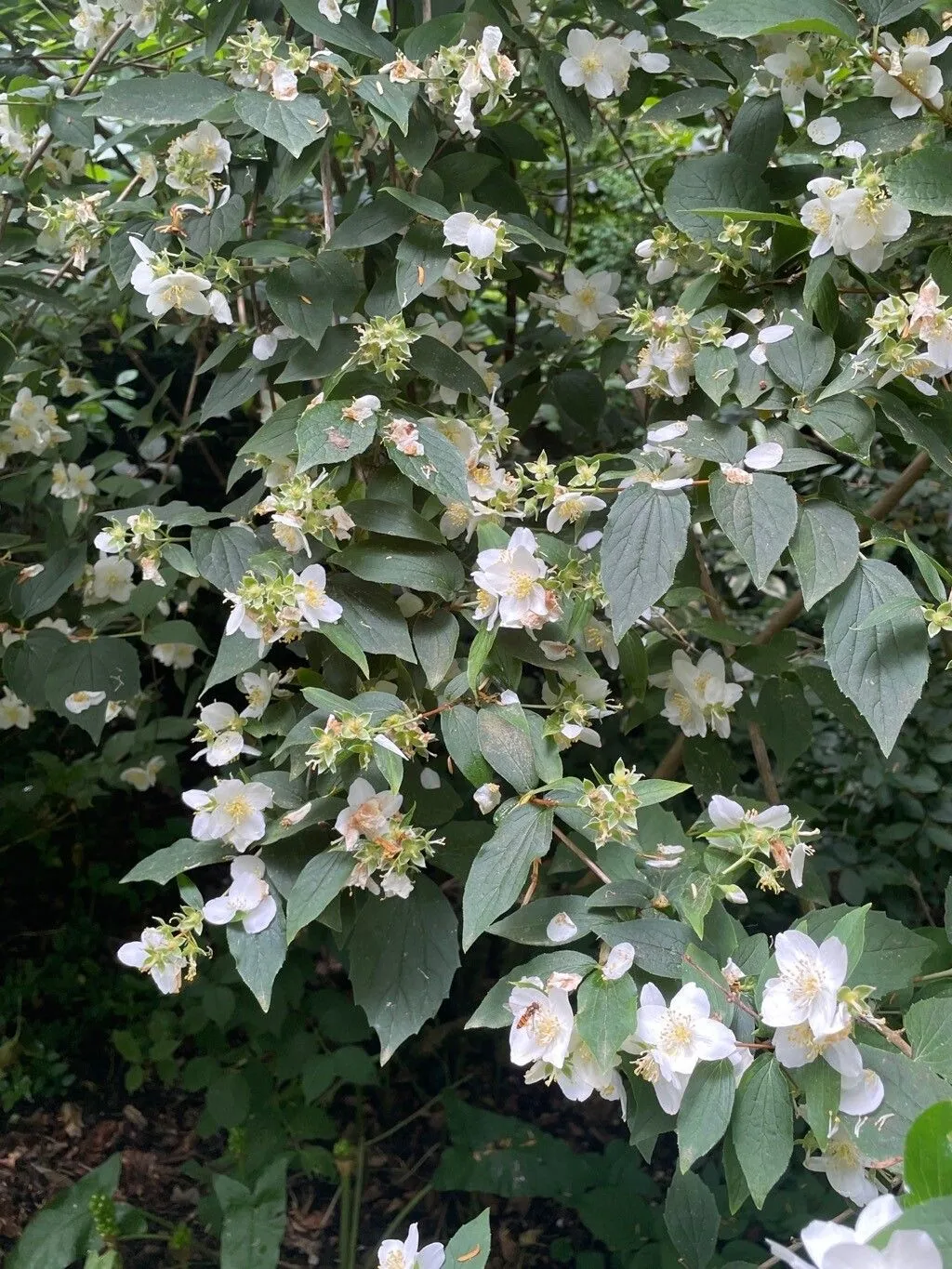
Author: Pursh
Bibliography: Fl. Amer. Sept. 1: 329 (1813)
Year: 1813
Status: accepted
Rank: species
Genus: Philadelphus
Vegetable: False
Observations: W. Canada to C. California
Lewis’s mock orange, scientifically known as Philadelphus lewisii, is a plant native to a broad geographical range extending from Western Canada down to Central California. This deciduous shrub is part of the Hydrangeaceae family, and it is celebrated for its aromatic and visually appealing blossoms which have captured the hearts of gardeners and natural landscape enthusiasts alike.
Philadelphus lewisii was first cataloged in 1813 by the botanist Pursh, who documented this species in his work “Fl. Amer. Sept.” This historical reference highlights the longstanding recognition of Lewis’s mock orange as a unique and valuable species within North America’s rich botanical tapestry.
The plant typically flourishes in a variety of habitats, showcasing its adaptability. It is commonly found in open forests, valleys, and hillsides where it benefits from both full sun and partial shade. Well-drained soils are ideal for its growth, although Philadelphus lewisii displays a remarkable tolerance to different soil types and conditions, further underscoring its hardiness and ease of cultivation.
The plant is most renowned for its profuse and fragrant white flowers, which bloom in late spring to early summer. These blossoms are not only beautiful with their delicate petals but also provide an alluring scent reminiscent of citrus and jasmine, drawing in bees, butterflies, and other pollinators. The foliage, consisting of dark green leaves, offers a lush backdrop that accentuates the striking white blooms.
Lewis’s mock orange does not just add aesthetic value to gardens; it also plays a role in traditional gardening practices and ecological restoration. Its dense growth habit makes it an excellent choice for hedges and screens, providing both privacy and windbreaks. Moreover, it serves as a valuable plant for erosion control on slopes and banks.
Philadelphus lewisii, with its historical significance and ecological versatility, stands as an exemplary species within its native regions. Its delightful fragrance and visual charm continue to make it a favorite among plant enthusiasts and ecologists, ensuring its place in both wild landscapes and cultivated gardens for generations to come.
Eng: lewis’ mock orange, lewis’s mock orange, wild mock orange, lewis’ mock-orange
Deu: oregon-pfeifenstrauch
Swe: gordonschersmin
Nno: lewisskjærsmin
Nob: lewisskjærsmin
Fra: seringa de lewis
En: Lewis’s mock orange, Wild mock orange, Lewis’ mock orange, Lewis’ mockorange, Syringa – mockorange, Lewis’ mock-orange
Fr: Seringa de Lewis
De: Oregon-Pfeifenstrauch
Nb: Lewisskjærsmin
Nn: Lewisskjærsmin
Sv: Gordonschersmin
Taken Jun 9, 2014 by Andrzej Konstantynowicz (cc-by-sa)
Taken Jun 5, 2011 by Andrzej Konstantynowicz (cc-by-sa)
Taken Jun 5, 2011 by Andrzej Konstantynowicz (cc-by-sa)
Taken Jun 9, 2014 by Andrzej Konstantynowicz (cc-by-sa)
Taken Jun 9, 2014 by Andrzej Konstantynowicz (cc-by-sa)
Taken Aug 5, 2021 by Veronique Boulanger (cc-by-sa)
Taken May 8, 2022 by Sara (cc-by-sa)
Taken May 8, 2019 by di scala ines (cc-by-sa)
Taken Jun 29, 2022 by David Hocken (cc-by-sa)
Taken Jun 7, 2022 by Andrzej Konstantynowicz (cc-by-sa)
Taken Jun 1, 2015 by EOL − penelopetowle (cc-by-nc)
Taken Jun 13, 2015 by EOL − Lindsey K. Wise (cc-by-nc)
Taken May 12, 2015 by EOL − sfmscott (cc-by-nc)
Taken May 23, 2015 by EOL − Wendy Anthony (cc-by-nc)
Taken Jun 29, 2022 by David Hocken (cc-by-sa)
© copyright of the Board of Trustees of the Royal Botanic Gardens, Kew.
© copyright of the Board of Trustees of the Royal Botanic Gardens, Kew.
Taken May 9, 2021 by Manuel Hernández (cc-by-sa)
Taken May 26, 2020 by maire sofia (cc-by-sa)
Taken Jun 26, 2022 by Veronique Boulanger (cc-by-sa)
Growth form>: Multiple Stem
Growth habit>: Shrub
Growth rate>: Moderate
Ph maximum: 8.0
Ph minimum: 7.0
Family: Myrtaceae Author: (F.Muell.) K.D.Hill & L.A.S.Johnson Bibliography: Telopea 6: 402 (1995) Year: 1995 Status:…
Family: Rubiaceae Author: Pierre ex A.Froehner Bibliography: Notizbl. Bot. Gart. Berlin-Dahlem 1: 237 (1897) Year:…
Family: Sapindaceae Author: Koidz. Bibliography: J. Coll. Sci. Imp. Univ. Tokyo 32(1): 38 (1911) Year:…
Family: Asteraceae Author: A.Gray Bibliography: Pacif. Railr. Rep.: 107 (1857) Year: 1857 Status: accepted Rank:…
Family: Fabaceae Author: Medik. Bibliography: Vorles. Churpfälz. Phys.-Ökon. Ges. 2: 398 (1787) Year: 1787 Status:…
Family: Aspleniaceae Author: (Cav.) Alston Bibliography: Bull. Misc. Inform. Kew 1932: 309 (1932) Year: 1932…